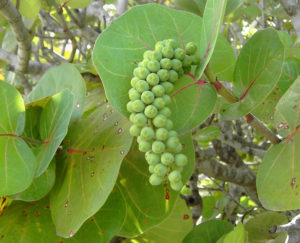Sea Grape Not Bearing Fruits

The sea grape plant can be grown as a tree, hedge, or shrub, this tropical beauty is native to tropical America, the Bahamas, the Caribbean, Bermuda, and the Greater and Lesser Antilles. The sea grape or the Coccoloba uvifera is a species of flowering plant in the buckwheat family, sea grapes are grown in many coastal areas because of their high salt tolerance and also serve as a dune stabilizer and protective habitat for small animals.
Humans are not the only ones that benefit from these berries, wildlife enjoys them as well, some of these wildlife are gopher tortoise, songbirds, beach mice, and lizards. The leaves of sea grapes are wide and rounded, the younger leaves are red but once mature turn a bright green color.
Sea grapes produce fruits from August through October, although some say from their experience Spring through Summer. The grapes grow in a cluster and are very sweet especially when they are dark purple. Below we’ll be discussing some reasons why your sea grapes may not be producing fruits.
Sea Grape Plant Care
I was asked the question why are my sea grapes not producing fruits? there are many answers to this question and what I believe is that by looking at the many whys? why a sea grape tree does not produce fruit will give us the answer.
Sea Grape Planting Location
Have you provided the right location or have you placed your sea grape tree in the right location? the location is so important because sea grapes are tropical plants they love the full sunlight which is a must for a sea grape to thrive and produce fruit.
Sea Grape Soil Type
Another factor that plays a big role in the life of a sea grape tree is the soil type, soil really does matters and is an important component that will determine whether your sea grape tree thrives along with producing fruits. Although sea grapes can grow in a wide range of soil the ideal soil is sandy soil that’s why sea grapes grow so well on beaches and other coastal areas.
Proper Installation
When installing sea grape trees the planting hole should be dug to about a foot wider than the root ball, this will make it much easier for this tree to establish as it produces new root growth. The depth of the root ball should not be to a depth where the entire root ball and part of the trunk are underground.
The planting hole should be dug to a depth where the entire root ball only is in the ground, the entire narrow trunk should be above ground. Planting too deeply will cause the sea grapes’ roots to suffocate which will lead to a nutrient deficiency.
Fertilizers
Fertilizers are nutrients that help to support plant life, a reason why a sea grape may not fruit is because of a lack of nutrients. Fertilizers can help in the fruiting process, Fertilizers that are great for fruiting plants and trees are 6-6-6, 8-8-8, or a balanced fertilizer. Before applying fertilizers read and follow the direction on the manufacturer’s label for the best results.
But from my experience, I have seen time and time again these grape trees producing berries in abundance without the use of fertilizers. However, if you still prefer to fertilize then another option is the use of organics. In this group, there is feather meal, soybean meal, cottonseed meal, blood meal, or compost chicken manure. These are great nitrogen sources, but be aware these organics can be pretty costly so you may have to pay a bit more.
Sea Grape Pests
Be on the lookout for leaf-feeding insects and sea grape borer, treat them as soon as possible, the adult seagrape borer is pale brown to yellowish. The wings of the adult moth are a rust color. The larva of this moth is legless, the pupa stage is brown. Control these insect pests by pruning and destroying infected plant parts.
If your seagrape plants are ever covered in a dusty dark mask this is the result of insects that are known as sucking insects that suck and ingest the plant’s fluids or sap. When the time comes for these insects to take a bathroom break they secrete a sugary substance known as honeydew which causes a mold to form the mold is this dark mask that covers your plants known as sooty mold. Two insects to watch out for that is responsible for this are mealybugs and whiteflies. Control these insect pests with organic insecticides.
Sea Grape Disease
What I have discovered over the years working with sea grape trees is diseases of these plants are like zero, I have never had to treat sea grape trees for any type of disease. This is truly a hardy plant, however, be careful not to overwater which can lead to root rot.
The final word on sea grape plant care
The sea grape tree is a winner, with this plant as a part of your garden and landscape you can’t go wrong, you have the best of both worlds with this garden beauty. A plant that provides food both for humans and wildlife along with a plant that’s drought and salt tolerant. I believe that the sea grape tree can bring much flavor to your garden literally speaking. Give this plant a try and see for yourself as you reap a good harvest of the delicious berries the sea grape tree produces.
About the author
Norman loves being in the garden, both at home and for his job....
he is 'Natures Little helper' being outdoors, growing his vegetables and flowers from an early age.
Now having spent over 22 years in the profession he want to give some of his knowledge to others...
his vast array of hints and tips you will find scattered over this site will help you no end growing plants in your garden.
